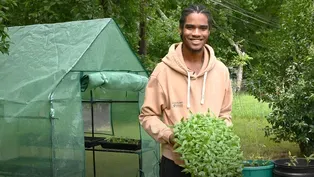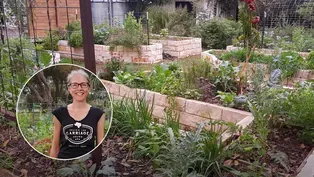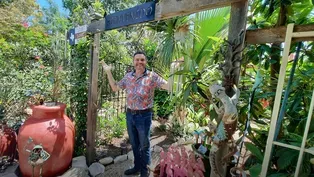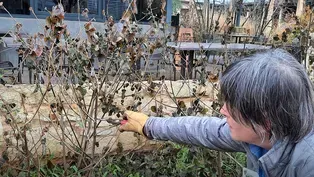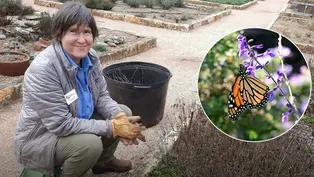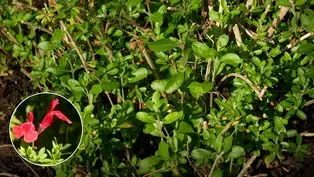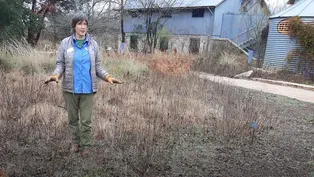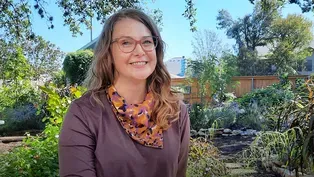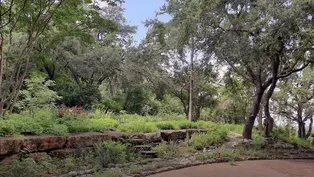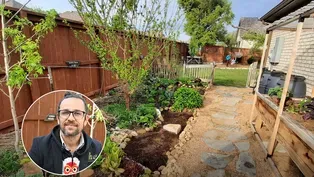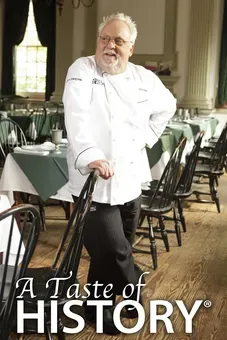
Winter Pruning: Autumn Sage
Clip: Season 28 | 4m 47sVideo has Closed Captions
Learn how to prune this evergreen woody shrub/subshrub.
Evergreen woody shrub/subshrub autumn sage (Salvia greggii) really benefits from late winter pruning, both for looks and long-term good health. See how to make the cuts with Leslie Uppinghouse, horticulturist at the Lady Bird Johnson Wildflower Center. Plus, learn when to tip prune and why to leave it alone in summer droughts.
Problems with Closed Captions? Closed Captioning Feedback
Problems with Closed Captions? Closed Captioning Feedback
Central Texas Gardener is a local public television program presented by Austin PBS
Support for CTG is provided by: Lisa & Desi Rhoden, and Diane Land & Steve Adler. Central Texas Gardener is produced by Austin PBS, KLRU-TV and distributed by NETA.

Winter Pruning: Autumn Sage
Clip: Season 28 | 4m 47sVideo has Closed Captions
Evergreen woody shrub/subshrub autumn sage (Salvia greggii) really benefits from late winter pruning, both for looks and long-term good health. See how to make the cuts with Leslie Uppinghouse, horticulturist at the Lady Bird Johnson Wildflower Center. Plus, learn when to tip prune and why to leave it alone in summer droughts.
Problems with Closed Captions? Closed Captioning Feedback
How to Watch Central Texas Gardener
Central Texas Gardener is available to stream on pbs.org and the free PBS App, available on iPhone, Apple TV, Android TV, Android smartphones, Amazon Fire TV, Amazon Fire Tablet, Roku, Samsung Smart TV, and Vizio.
Providing Support for PBS.org
Learn Moreabout PBS online sponsorshipHi, I'm Leslie Uppinghouse.
We're here at the Lady Bird Johnson Wildflower Center.
And today we're talking about pruning woody perennials.
So the plant that I have in front of me is the autumn sage Salvia greggii.
This is a long living woody perennial.
Some people would call it a sub shrub.
The wood on this plant can be particular, really brittle as it grows older.
Utilize the plant to tell you where you're going to cut.
So I've done a little bit of pruning already and you can see inside the plant that I haven't pruned the bright green leaves at the base.
And if you look at all of the plants in this bedding, you can see that they are all about the same height.
So that is going to give you the visual indication of where you're going to cut.
The other thing that I'm going to do is I'm going to make sure that I'm nice and comfortable.
So I'm on a stool.
I'm pretty much at eye level so I can see clearly where I'm going to cut.
And I'm also going to have a variety of very sharp tools so I can make sure to make a nice clean cut above the node right where that nice, bright green new growth is coming.
So this is new growth that is coming for the next season.
So this old growth wood that is green is still kind of fresh, but we're going to go for the new green at the very base.
So I'm going to start with the smallest clippers I have.
When you're doing something brittle, you want to make sure to not overstress the tissue of that branch.
So I'm not going to use loppers, I'm not going to use shears and I'm not going to use big clippers.
I do have the big clippers here in case I need to cut some of that.
Woody older growth that is holding the plants form kind of together.
But I'll show you what I mean.
So with my little tiny snips, I'm going to go right above the node and a nice bright green and I'm just going to make a quick clean cut.
There's a little bit of resistance on the clippers, but I feel pretty good about it.
Salvias can have wood, old wood, but you want to be careful that it doesn't get too woody because a dog can rub up against it and snap that branch.
Some of the blooms are going to really be a little bit showier on that bright green growth, which makes sense if you think about it.
The new growth is going to be flush here.
And I'm going to show you a couple of examples.
I'll cut one.
So just trimming a little bit, this is a very small diameter plant.
It's got a lot of green growth.
But you can see here and here I'm going to switch to my bigger pruners because I'm talking about more wood.
So a little bit, I'll call it my mediums, but I'm going to cut this one really at the base just to show the example.
So look at the diameter difference between these two branches.
So they're quite a bit bigger the older they get and you'll want to look for your oldest branches and make sure that they're still viable, that they're still showing a lot of fresh green growth.
And if they're not, don't hesitate to cut it to the ground and have some of that new growth.
But I wouldn't recommend removing all of your old growth.
I treat autumn sage kind of like a rose, a very old tea rose.
About every three years I take out my oldest stalks and I let some of those new ones sort of take their place.
And so that's sort of the general rule I make with all the subshrubs or the woody shrubs.
And that's not a hard, fast rule.
It's just my preference.
So you can see now I'm kind of keeping with my mediums.
It's not squishing any of that tissue.
I'm going to work a little bit faster.
Autumn sage depending on where you are and what type of irrigation or if you're irrigating, it all can be a little bit susceptible to rot if it is too moist.
So this is a good time of year while I'm trimming to really check out the base of the plant, make sure my mulch isn't too high.
So this is an example of winter pruning, but I would almost call it shaping versus cut back.
You can shape this plant Salvia greggii multiple times a year.
I like to do it in the winter.
We're in January right now, but I like to wait until after a freeze.
This plant can bloom as early as February.
Typically, it will be around March or April after a big bloom, I like to go back and I'll tip it.
I'll tip off those blooms, maybe about not even a third of the plant.
I'll tip back to some nice green growth and then I do it again in the summertime.
I do not prune it if we are in a drought year.
In the late summer, it tends to be a little stressful on that plant.
For Backyard Basics, Im Leslie Uppinghouse.
Growing Community: Body and Soul
Video has Closed Captions
Lenny West found his anchor and mission in providing fresh vegetables to food desert neighbors. (6m 18s)
Native Plant Garden in HOA: Martin Byhower
Video has Closed Captions
A California-to-Texas environmentalist helps neighbors garden for wildlife in extreme weather. (8m 42s)
Permaculture Design: Raised Beds and Food Forest
Video has Closed Captions
Limestone raised beds and a mandala-designed food forest honor resourceful permaculture tenets. (9m 15s)
Creating Moods in a Regular Backyard
Video has Closed Captions
Imagination, creative reuse, and spirited fun turned a backyard into a sensory voyage. (7m 41s)
Video has Closed Captions
New gardener Nancy Hall relied on plants–adapted and native–to teach her their ways. (7m 49s)
Artistic Collaboration Goes with the Flow
Video has Closed Captions
When rainwater runoff plagued a family’s home, they plunged into a whimsical makeover. (8m 25s)
Winter Pruning: Wax Mallow for Spring’s Spiderworts
Video has Closed Captions
See how to cut back wax mallow (turk’s cap) to show off spring-blooming spiderworts. (3m 25s)
Winter Pruning: Mealy Blue Sage
Video has Closed Captions
See where to cut back old stalks on perennial mealy blue sage. (3m 16s)
Video has Closed Captions
Learn how to prune this evergreen woody shrub/subshrub. (4m 47s)
Video has Closed Captions
See why to progressively prune grasses and herbaceous perennials. (1m 35s)
Garden Makeover Grows New Friends and Career
Video has Closed Captions
Jennie Ostertag broke a few shovels changing her yard and life’s path. (9m 18s)
Video has Closed Captions
James Truchard created diverse habitats to offset a future of climate changes. (8m 49s)
Drought Design: Change of Plans & Plants
Video has Closed Captions
Mistakes led new gardeners back to the drawing board with native plants. (8m 55s)
Side Yard Garden Permaculture Design
Video has Closed Captions
A narrow side yard supports food and flowers with permaculture techniques. (8m 1s)
Front Yard Native Plant Wildlife Habitat
Video has Closed Captions
Removing lawn for native plants brings pollinators to a young couple’s front yard. (9m 35s)
Providing Support for PBS.org
Learn Moreabout PBS online sponsorshipSupport for PBS provided by:
Central Texas Gardener is a local public television program presented by Austin PBS
Support for CTG is provided by: Lisa & Desi Rhoden, and Diane Land & Steve Adler. Central Texas Gardener is produced by Austin PBS, KLRU-TV and distributed by NETA.
